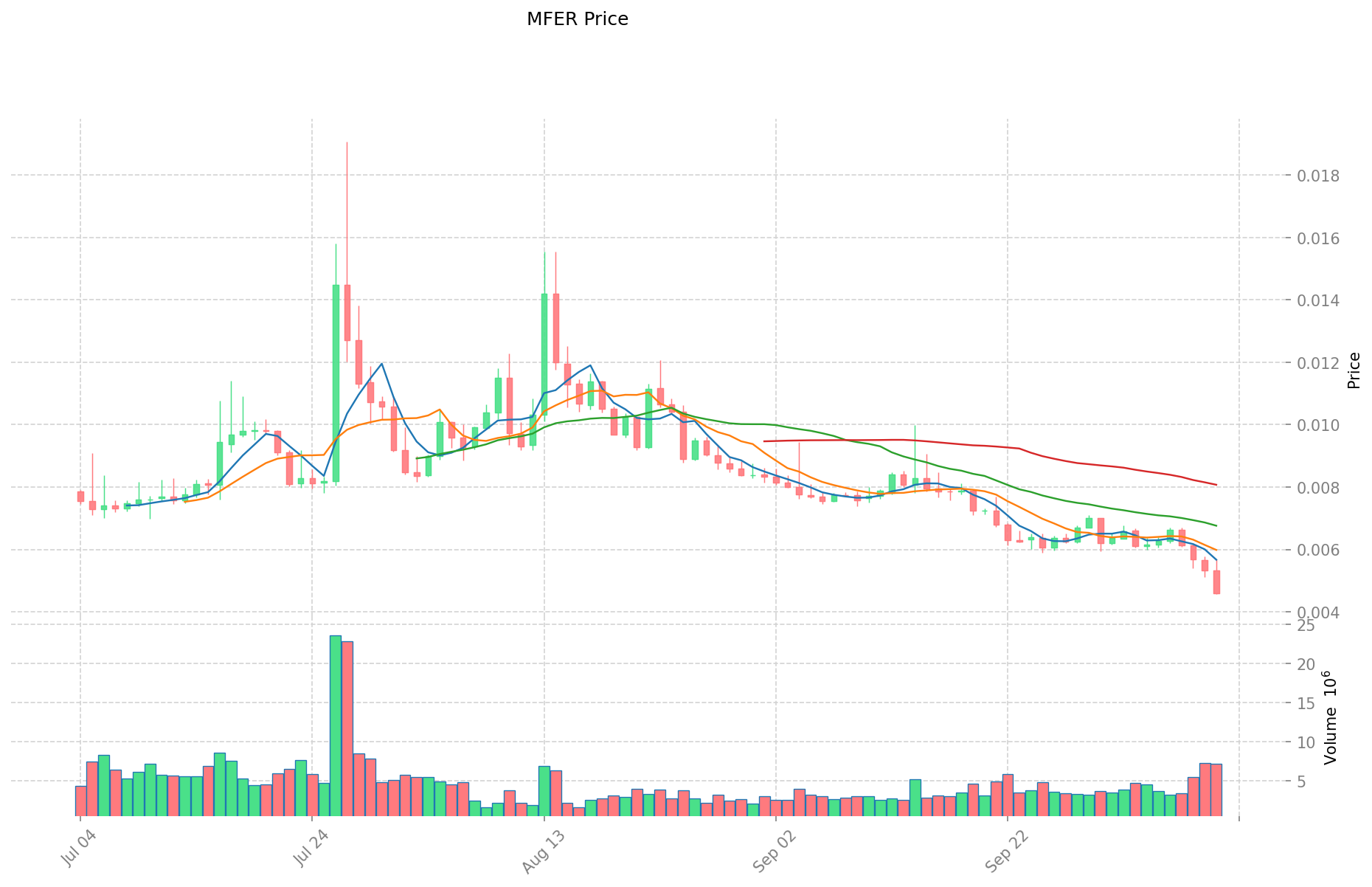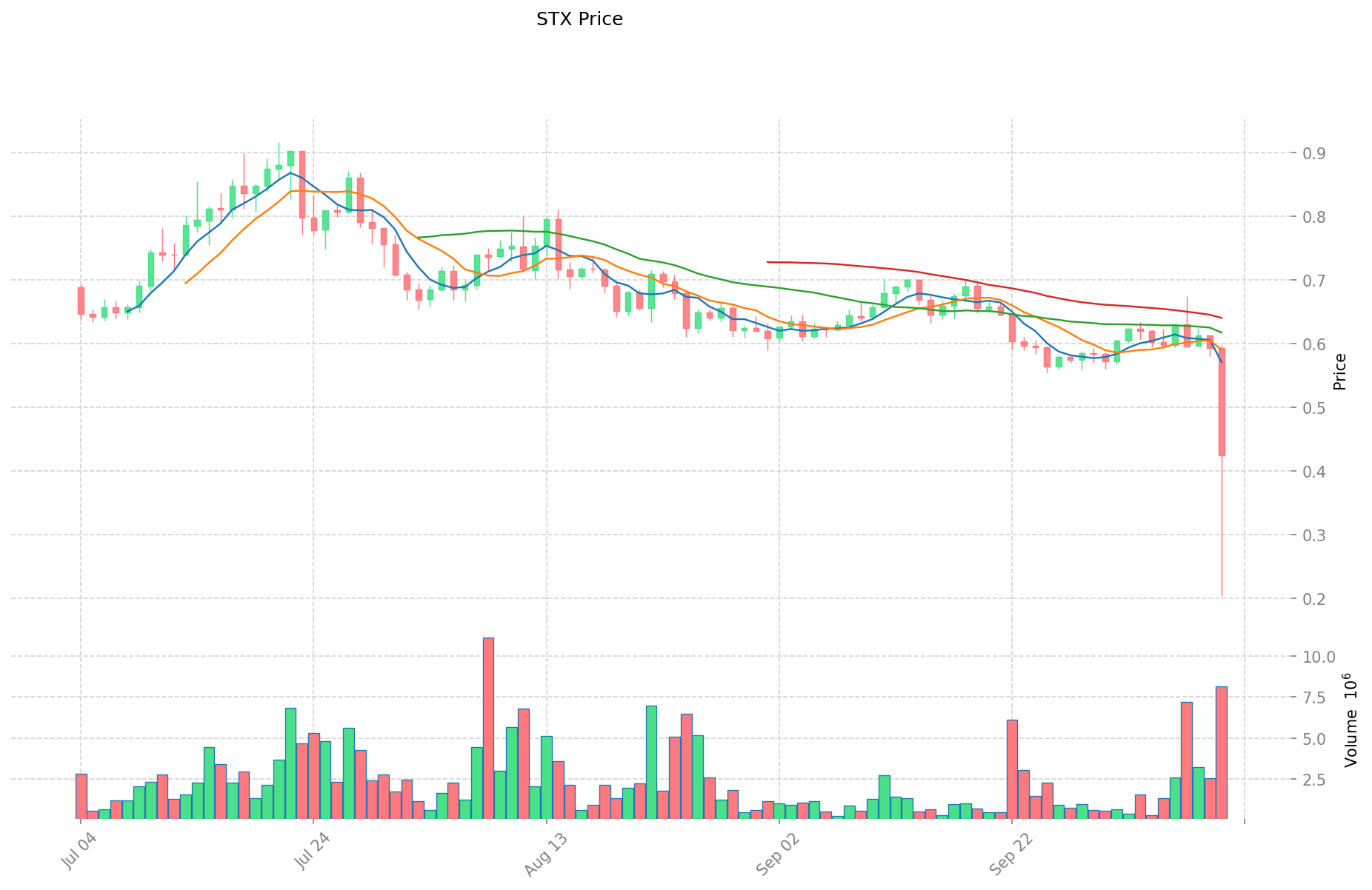MFER vs STX: A Comparison of Two Emerging Cryptocurrency Projects
Introduction: Investment Comparison between MFER and STX
In the cryptocurrency market, the comparison between MFER vs STX has always been a topic that investors cannot ignore. The two not only have significant differences in market cap ranking, application scenarios, and price performance, but also represent different positions in crypto assets.
MFER (MFER): Launched in 2024, it has gained market recognition for its "peer-to-peer electronic mfer system".
STX (STX): Since its introduction in 2019, it has been hailed as a "new Internet for decentralized applications", and is one of the cryptocurrencies with high global trading volume and market capitalization.
This article will comprehensively analyze the investment value comparison between MFER vs STX, focusing on historical price trends, supply mechanisms, institutional adoption, technical ecosystems, and future predictions, and attempt to answer the question that investors are most concerned about:
"Which is the better buy right now?"
I. Price History Comparison and Current Market Status
MFER and STX Historical Price Trends
- 2024: MFER reached its all-time high of $0.2988, likely due to increased market interest.
- 2024: STX hit its peak price of $3.86, possibly influenced by positive developments in the Stacks ecosystem.
- Comparative analysis: In the recent market cycle, MFER has fallen from its high of $0.2988 to a current price of $0.004725, while STX has declined from $3.86 to $0.4408.
Current Market Situation (2025-10-11)
- MFER current price: $0.004725
- STX current price: $0.4408
- 24-hour trading volume: $36,547.06 (MFER) vs $4,362,516.90 (STX)
- Market Sentiment Index (Fear & Greed Index): 27 (Fear)
Click to view real-time prices:
- Check MFER current price Market Price
- Check STX current price Market Price


II. Key Factors Affecting Investment Value of MFER vs STX
Supply Mechanism Comparison (Tokenomics)
- MFER: Based on the community statement "1$mfer=1$mfer", suggesting a community-driven value proposition rather than technical tokenomics
- STX: Functions as a Bitcoin Layer2 network solution with its own technical value proposition
- 📌 Historical pattern: Supply mechanisms drive price cycles differently based on community support for MFER versus technical utility for STX.
Institutional Adoption and Market Applications
- Institutional holdings: STX appears to have more formal investment analysis as indicated by research into its Layer2 network value
- Enterprise adoption: STX has potential applications through its Bitcoin Layer2 network technology
- Regulatory attitudes: Limited information available from the provided sources
Technical Development and Ecosystem Building
- MFER technical development: Primarily driven by community support rather than technical innovation
- STX technical development: Positioned as a Bitcoin Layer2 network solution with ongoing technical development
- Ecosystem comparison: STX appears to have more technical ecosystem development as a Layer2 solution
Macroeconomic Factors and Market Cycles
- Inflation performance: Bitcoin investor demand noted as a key price driver, potentially affecting STX as a Bitcoin Layer2 solution
- Monetary policy impact: Limited information in provided sources
- Geopolitical factors: Limited information in provided sources
III. 2025-2030 Price Prediction: MFER vs STX
Short-term Prediction (2025)
- MFER: Conservative $0.00435 - $0.00473 | Optimistic $0.00473 - $0.00586
- STX: Conservative $0.2509 - $0.4402 | Optimistic $0.4402 - $0.5194
Mid-term Prediction (2027)
- MFER may enter a growth phase, with prices estimated between $0.00350 - $0.00881
- STX may enter a stable growth phase, with prices estimated between $0.2682 - $0.5463
- Key drivers: Institutional capital inflow, ETF developments, ecosystem growth
Long-term Prediction (2030)
- MFER: Base scenario $0.00749 - $0.00913 | Optimistic scenario $0.00913 - $0.01251
- STX: Base scenario $0.4659 - $0.6852 | Optimistic scenario $0.6852 - $0.9387
Disclaimer
MFER:
| 年份 | 预测最高价 | 预测平均价格 | 预测最低价 | 涨跌幅 |
|---|---|---|---|---|
| 2025 | 0.00586396 | 0.004729 | 0.00435068 | 0 |
| 2026 | 0.0072032128 | 0.00529648 | 0.0041312544 | 12 |
| 2027 | 0.008812283424 | 0.0062498464 | 0.003499913984 | 32 |
| 2028 | 0.00820886075408 | 0.007531064912 | 0.0041420857016 | 59 |
| 2029 | 0.010388350939612 | 0.00786996283304 | 0.004643278071493 | 66 |
| 2030 | 0.012506944934267 | 0.009129156886326 | 0.007485908646787 | 93 |
STX:
| 年份 | 预测最高价 | 预测平均价格 | 预测最低价 | 涨跌幅 |
|---|---|---|---|---|
| 2025 | 0.519436 | 0.4402 | 0.250914 | 0 |
| 2026 | 0.51340526 | 0.479818 | 0.36466168 | 9 |
| 2027 | 0.546272793 | 0.49661163 | 0.2681702802 | 13 |
| 2028 | 0.7300190961 | 0.5214422115 | 0.453654724005 | 19 |
| 2029 | 0.744619478022 | 0.6257306538 | 0.325379939976 | 43 |
| 2030 | 0.93868984029807 | 0.685175065911 | 0.46591904481948 | 57 |
IV. Investment Strategy Comparison: MFER vs STX
Long-term vs Short-term Investment Strategy
- MFER: Suitable for investors focused on community-driven projects and potential meme coin growth
- STX: Suitable for investors interested in Bitcoin Layer2 solutions and blockchain infrastructure development
Risk Management and Asset Allocation
- Conservative investors: MFER: 10% vs STX: 90%
- Aggressive investors: MFER: 30% vs STX: 70%
- Hedging tools: Stablecoin allocation, options, cross-currency portfolios
V. Potential Risk Comparison
Market Risk
- MFER: High volatility due to meme coin nature and community sentiment
- STX: Susceptible to Bitcoin market trends as a Layer2 solution
Technical Risk
- MFER: Limited technical development, reliance on community support
- STX: Scalability challenges, network stability issues related to Bitcoin Layer2 implementation
Regulatory Risk
- Global regulatory policies may impact both differently, with potentially higher scrutiny on STX due to its technical nature
VI. Conclusion: Which Is the Better Buy?
📌 Investment Value Summary:
- MFER advantages: Strong community support, potential for rapid price movements
- STX advantages: Technical utility as a Bitcoin Layer2 solution, ecosystem development potential
✅ Investment Advice:
- New investors: Consider a small allocation to STX for exposure to Bitcoin ecosystem development
- Experienced investors: Balanced approach with a larger allocation to STX and smaller speculative position in MFER
- Institutional investors: Focus on STX for its technical proposition and potential long-term value in the Bitcoin ecosystem
⚠️ Risk Warning: The cryptocurrency market is highly volatile, and this article does not constitute investment advice. None
VII. FAQ
Q1: What are the key differences between MFER and STX? A: MFER is a community-driven meme coin launched in 2024, while STX is a Bitcoin Layer2 network solution introduced in 2019. MFER relies on community support, whereas STX offers technical utility in the Bitcoin ecosystem.
Q2: Which cryptocurrency has shown better price performance recently? A: Based on the provided data, STX has shown better price performance. While both have declined from their all-time highs, STX's current price of $0.4408 represents a smaller percentage drop compared to MFER's current price of $0.004725.
Q3: How do the supply mechanisms of MFER and STX differ? A: MFER's supply mechanism is based on the community statement "1$mfer=1$mfer", suggesting a community-driven value proposition. STX, on the other hand, has a supply mechanism tied to its function as a Bitcoin Layer2 network solution with its own technical value proposition.
Q4: What are the main factors affecting the investment value of MFER and STX? A: Key factors include price history, supply mechanisms, institutional adoption, technical development, ecosystem building, and macroeconomic factors. STX appears to have stronger institutional adoption and technical ecosystem development.
Q5: How do the long-term price predictions for MFER and STX compare? A: For 2030, MFER's base scenario predicts a range of $0.00749 - $0.00913, with an optimistic scenario of $0.00913 - $0.01251. STX's base scenario for 2030 predicts $0.4659 - $0.6852, with an optimistic scenario of $0.6852 - $0.9387. STX shows higher predicted values overall.
Q6: What are the recommended investment strategies for MFER and STX? A: For conservative investors, a 10% MFER to 90% STX ratio is suggested. For aggressive investors, a 30% MFER to 70% STX ratio is recommended. STX is generally considered more suitable for long-term investment due to its technical utility.
Q7: What are the primary risks associated with investing in MFER and STX? A: MFER faces high volatility due to its meme coin nature and reliance on community sentiment. STX is susceptible to Bitcoin market trends and potential technical challenges related to its Layer2 implementation. Both face regulatory risks, with STX potentially facing higher scrutiny due to its technical nature.
Share
Content